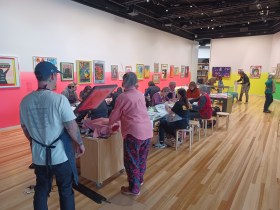In this article:
According to the latest Creative Australia economic study of artists in Australia, around 20% of working artists in this country do not have proper superannuation arrangements in place.
The report, part of Creative Australia’s six-yearly survey of artists’ working conditions and incomes, puts the number of artists currently receiving super payments in their work as an employee (as opposed to being an independent contractor or a small business) at just under half of those surveyed.
Another 29% registered as having industry super funds, which presumably means they are making payments to those super funds themselves as sole trader businesses and/or independent contractors, or they are receiving payments to those super funds from their clients as they earn their income (more on this complex area later).
This means around 20% of the creative workforce are not receiving super payments of any kind. Instead, these artists’ future financial security rests on their personal savings, other investments or support they receive from their partners or families.
Either way, the report shows an alarmingly high number of these creative professionals hold dim views of their future financial security, with four in 10 artists surveyed saying they do not consider their financial arrangements for the future to be adequate.
This leads to a very important (but often neglected) conversation about artists and superannuation, and why being paid super as part of your work as a creative professional could make the world of different to your financial security in years to come.
However, when it comes to what the law currently says about paying super to creative freelancers, the story is not plain and simple. Rather, there are ambiguities in some of the government guidelines that can sometimes make it hard for certain artists to know their rights.
Below are a series of best steps you can follow if you are feeling confused, but please note the below cannot be taken as official legal advice. For individual queries on your rights, consult the Australian Taxation Office directly and/or seek legal counsel.
Step 1: am I an employee or a contractor?
In terms of who is responsible for paying which part of your income (i.e your “wage”, your tax liability and your superannuation) the first all-important question to ask yourself is about the nature of the work you are doing (i.e are you an employee or a contractor?).
If your work fits the definition of an employee, then your employer must do the following things: a) they must pay you your net wage, b) they must pay the Australian Taxation Office (ATO) your estimated tax liability, and c) they must make a superannuation payment to your super fund, which is calculated as 11% of your gross wage.
Whether your work fits the legal criteria of an employee comes down to a range of factors, which you can find here on the ATO’s website. Basically, the definition of what an employee is is shaped around the level of agency and control you have over your work.
For example, if you are being instructed in your work and it’s being done under supervision according to hours that you don’t set yourself, then you are most likely an employee.
But if you set your own hours, work in an unsupervised way, and are responsible for delivering a “result” for your client (rather than being paid for the hours you are working), then it is likely you are legally defined as a contractor.
So, if you are an employee in the arts, the super rules are very simple: your employer must make routine payments to your super fund to the tune of 11% of your gross wage.
But if you are an independent contractor, things are more complicated, because you don’t have an employer who is paying you a wage. Instead, it’s generally up to you (as the owner of your own business) to decide whether you pay yourself super or not.
However, there are some important caveats around those guidelines, and this is where things can get murky – so read on.
Step 2: does my work involves a ‘performance’?
According to the ATO’s most recently published publicly available guidelines on superannuation entitlements, there are certain independent contractor roles – many of which relate directly to the arts – that are automatically subject to super payments.
As per the ATO’s most recent advice, the following contractor-workers must be paid 11% super on top of their set fees:
1/ workers being paid under a contract that is wholly or principally for their labour
2/ a sportsperson, artist or entertainer paid to perform, present or participate in any music, play, dance, entertainment, sport, display or promotional activity, or similar activity
3/ a person paid to provide services in connection with any performance, presentation or participation in these activities, and
4/ a person paid to perform services related to the making of a film, tape, disc, television or radio broadcast.
So, let’s say that you, as a creative worker, are engaged by a local government agency to deliver a series of five hour-long children’s theatre performances during the school holidays. You have created the theatre work you will perform, and you will use all your own “tools of the trade” (i.e. set, costumes etc) to deliver those shows.
You have negotiated your total fee for this work will be $2000 including GST, for which you will invoice your client at the end of the run. So, in this situation, does your client have to pay you your invoiced amount of $2000, plus an additional $220 (i.e. 11% of your $2000 artist fee) directly to your super fund?
The answer, according to the guidelines above, is yes, they do, because the nature this work revolves around your services in connection with a “performance”.
But if you are not doing work that involves a “performance” or a “presentation”, and are instead delivering something that is perhaps more like a series of art workshops for kids… Are the rules different in these cases?
The answer is… Maybe, because the language around what constitutes a “performance” or “presentation”, and what defines work that is “wholly or principally about labour” is subject to interpretation, and the current guidelines do not necessarily present clear answers.
This is why it is sometimes difficult for both the artist and their clients to work out what the legal rules around paying superannuation are, because the roles outlined in the ATO’s current guidelines are limited in their descriptions.
Step 3: things you can do if you are still unsure
The good news is that there is at least one seasoned arts professional who has done some serious homework in this area, and has discovered some effective ways to work with the legal guidelines as they stand.
Narelle Vogel is a creative producer of 30 years’ experience in the sector. She is currently based in Albury, NSW, and works on a range of arts projects that have touch points (and clients) both inside and outside of the arts.
She says that when it comes to the superannuation rules relevant to her freelance work, she finds that it’s usually clients outside of the arts who are least aware of the nuances around paying creative workers super.
As she tells ArtsHub, ‘It’s often harder for those [non-arts] businesses to understand how my role as an independent contractor might be different to that of, say, a plumber or electrician independent contractor when it comes to paying super,’ she explains.
To avoid misunderstandings, Vogel prioritises straightforward and professional conversations with her clients from the earliest stages, to allow them to understand how she sets her hourly rate and her expectations around super payments.
‘Some clients are initially confused by the information I give them [about super] because it’s not the way they are used to dealing with contractors, and their systems aren’t necessarily set up for paying contractors super,’ Vogel says.
‘But often, they are happy to be informed about what the law is, and because I’m professional in my approach [in informing them], it doesn’t become a big issue.’
However, there have been a few instances where Vogel’s interpretation of the law has differed from her clients, and those clients have refused to pay her super on top of her fee.
‘In those cases, I’ve proposed to the client that both of us go through the ATO’s reporting process to seek clarity about whether or not the work that I’ve done for them should have involved them paying me super,’ she says.
Vogel says these ATO reporting mechanisms have been an incredibly useful means to help her take fair and reasonable action to address what she sees as discrepancies in her clients’ understandings of the law.
‘I do this work for my own sake as a creative professional, but I also see it as important for the sector more broadly,’ she says.
‘Many artists and creatives have missed out on being paid super for large parts of their careers and it’s left them financially vulnerable. So, we need to be getting the message out more that there are many creatives who are, in fact, entitled to super payments as part of what they do.
‘I think this is especially for our younger artists who are just starting out,’ she adds.
‘We need to make sure those emerging artists know that it’s a very important part of their incomes, and that they deserve it, too.’






